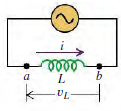Equation (31.9) says that v ab = L di/dt (see Fig. 31.8a). Using Faradays law, explain why
Question:
Fig.31.8

Fantastic news! We've Found the answer you've been seeking!
Step by Step Answer:
Related Book For 

University Physics with Modern Physics
ISBN: 978-0133977981
14th edition
Authors: Hugh D. Young, Roger A. Freedman
Question Posted:





